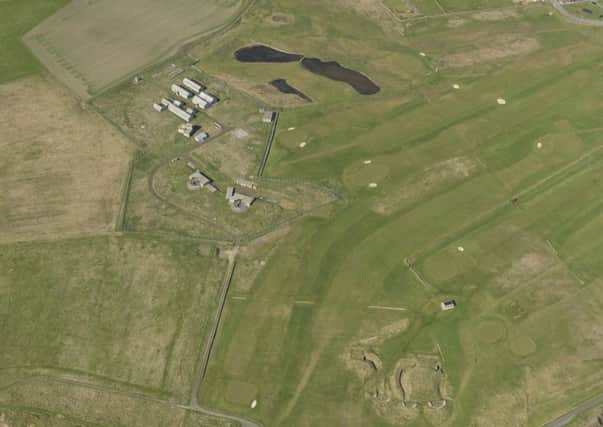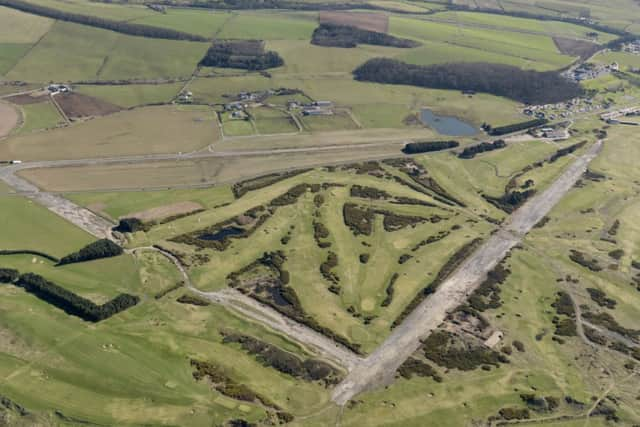‘Lost’ golf courses recorded for new project


Now some of these 250 former courses have been formally recorded as part of a project by RCAHMS to establish a comprehensive database on Scotland’s landscape.
RCAHMS also holds aerial photography of each of Scotland’s golf courses. It has recently been taking high quality digital photography of more than 500 current playing courses on the mainland of Scotland from the air, including Gleneagles, host to the 2014 Ryder Cup.
Advertisement
Hide AdAdvertisement
Hide AdThese aerial photos can now be viewed online – on the Britain from Above website and on Canmore, the national database on the built environment of Scotland - alongside other records such as historic photographs, original designs for courses and club houses and recent photography of a number of significant buildings connected to the sport of golf in Scotland.


The records have also drawn on listings information held by Historic Scotland: five clubhouses in Scotland carry a Category “A” listing including Pitfirrane Castle, Dunfermline Golf Club and Ratho Park Golf Club. There are a number of other listed clubhouses, but most are B or C.
Many of Scotland’s golf course sites – both those that remain playable and the lost courses recorded by RCAHMS historic land use assessment - reflect the social and economic history of 20th century Scotland.
“Lunatic” asylum golf courses were part of a 19th century movement for sport, which eventually became seen as an outdated idea.
In the early 20th century with cheaper travel and increased leisure activity, hotels were built connected to golf courses, as at Turnberry. Peoples’ holiday habits changed in the 1950s as they started to go abroad, and with increasing maintenance costs many of these hotels and golf courses closed.
Private golf courses existed in the late 19th and early 20th century where country house owners had disposable income. But these courses were often short lived, they tended to be personal projects and often descendents were less interested in spending money on maintaining a golf course.
Military golf courses were equally likely to be short lived: set up by a commanding officer to provide recreation for military personnel, occurred during both world wars, but especially so just after WWII on disused airfields.
While some ‘lost’ courses have gone forever, their layouts returned to agricultural land, the surviving sites offer an insight into early golf course design.
Advertisement
Hide AdAdvertisement
Hide AdSome of Scotland’s ‘lost’ golf courses – as well as courses lost, but now restored - include:
• Burghead and Duffus Golf Club (Grampian) which occupied an area of moorland to the east of Burghead founded in 1896 and closed 1940. The clubhouse is still evident on a 1945 aerial view but today all evidence of the clubhouse has gone, while the footprint of the course is retained within a group of arable fields.
• Cramond Brig Golf Club (Edinburgh), founded in 1907, this 18-hole golf course was situated on part of the designed landscape of Cammo House owned by the Maitland-Tennent family. By the early 1920s there were over 700 members but when the lease expired in 1929 the Club moved to a new location at Dalmahoy. Now only the Arts and Crafts clubhouse survives as a ruin.
• Scallaway Golf course (Shetland) originally founded in 1907, it disappears from the records in the early 1950s, reappears in the late 1950s, is depicted on an OS map dated 1971before disappearing again in the early 1980s.
• Hill of Tarvit Mansionhouse (Fife) Private golf courses created in the grounds of country houses are not uncommon in the 20th Century. Most were short lived and quickly returned to pasture and few have survived in playable condition. The National Trust recreated this 1920s private golf course (opened again in 2008) and only hickory golf clubs and replica 1920s golf balls are used, enabling the modern player to experience how different golf was in the early 20th century.
• Glasgow, Leverndale Hospital, Leverndale Golf Course (Strathclyde) Victorian lunatic asylums had extensive grounds and this 9-hole course would have been constructed as a recreation facility for staff and patients. The course at Leverndale is depicted on an OS map dated 1972 but today most of it is waste ground with the eastern section lost under a housing development.
• Aviemore Golf Hotel (Highlands) this large hotel burnt down in 1950 and its – once substantial - golf course fell out of use. Aerial photographs from 1966 show the construction of the Aviemore Highland Resort on the site of the hotel and adjacent land.
• Kippford Golf Club (Dumfries and Galloway) Founded in 1905, this nine-hole course occupied two fields to the north of Kippford, adjacent to the Pines Hotel. The course was converted to farmland by the 1960s and is now lost under a large coniferous plantation. The Pines Hotel survives as a private residence.
Advertisement
Hide AdAdvertisement
Hide Ad• Roan Head course (Flotta) The eighteen-hole golf course on the island of Flotta was built and maintained by the navy around World War 1. Thought and effort went into creating this course in a remote part of Scotland. Commander King-Hall described how each big ship designed and constructed a hole with one battleship spending over £70 to source turf from a famous Scottish golf course. This may well have been the battleship HMS Canada or the King George V as it is reported by Commander King-Hall that a green designed by one of these vessels was as smooth as a billiard table (Stell 2010). Other remote golf courses in Scotland survived for longer because of a strong military presence, like Coldingham of Abbs Golf Club, Borders.
• Tayside (Perthshire) Perth has a strong golf history and at least 27 relict sites. In 1502 King James IV of Scotland (1473-1513), a keen golfer, is recorded as having bought clubs from a Perth bow maker. It seems likely that golf must have been played on the North Inch then, and is still played there now although the current course has expanded north into farming ground and the south half has been converted into recreation ground. Mary Queen of Scots (1542-1587) reportedly played golf on the South Inch, supposedly the first place in Scotland where a course was laid out. The evidence is hazy but it seems likely that golf was played here throughout the 17th and 18th C, dying out around the 1850s
Speaking on behalf of RCAHMS Clare Sorensen, Curator said “Golf is an important part of many people’s lives in Scotland whether they play for fun or gain their living from it.
“Although the last few years have sadly seen some of Scotland’s smaller clubs and courses close down, this is not a new phenomenon and we can see that there are over 250 sites throughout Scotland where golf was once played, but no longer is.
“Historical records and photographs might be the only evidence although a few leave traces of their designs in the landscape that we can photograph from the air.
“There are also new clubs and courses being created around the country; clearly the historic links with the sport of golf in Scotland continues to this day.
“We’re hoping that people will help us build up the national record in the Canmore or Britain from Above websites sharing information about their own golf clubs and clubhouses, and any historic and modern photographs that they might have.”